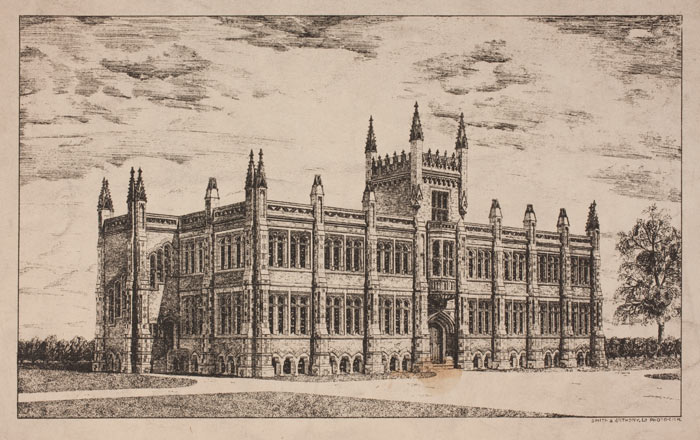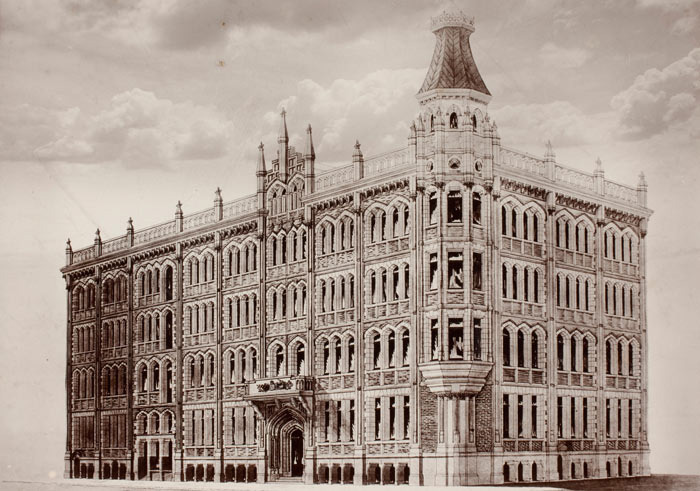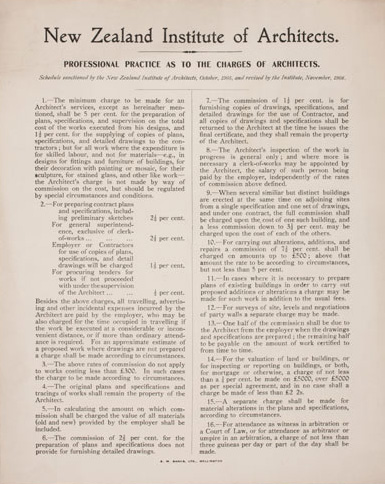The first phase in the architectural process was the creation of concept or presentation drawings. Concept designs could be used to secure contracts from clients, or be submitted to architectural competitions. It was essential therefore that architects both understand design, and have advanced artistic drawing skills. Little wonder then that emerging courses of instruction in architecture focused so keenly on drawing skills. Samuel Hurst Seager believed that “Though an architect as such, need not have sufficient skill with the pencil or brush to enable him to rank as a painter, he nevertheless must have sufficient power of draughtsmanship to enable him to adequately express his ideas in order that they may be readily understood and faithfully carried out."

The Concept Drawing

A reproduction of the Collins and Harman presentation drawing for the proposed Canterbury College Chemistry Laboratory, dated 1906.
Prior to the 1860s initial concept drawings generally concentrated on showing just the design of the building in black and white without much embellishment, and designs were not always shown with perspective indicated. From the 1860s onwards however, concept drawings increasingly took on ‘picturesque’ qualities, which often showed the initial design for a building set in idealized landscapes. Design concept drawings started to become artistic works in their own right. Lovingly tinted and hand coloured, they were no longer just utilitarian drawings set down to meet the clients’ needs. This trend was further reinforced by the development of halftone printing processes from the 1890s onwards, which allowed architectural journals to reproduce drawings in showing tone and shading. A simple line drawing would not look half so impressive alongside a painterly presentation drawing in such a publication.

A copy of the presentation drawing for the Press Building, designed by J.G. Collins, found in the Armson Collins archive collection.
One further result of the change in the way concept drawings were presented was the development of architectural firms starting to catalogue and preserve their own collections of drawings. The more time and effort invested in concept drawings, the more worth they had in being preserved for future reference and promotion. J.G. Collins' exquisite rendering of the concept drawing for The Press building, completed in 1909, is a perfect example of Samuel Hurst Seager’s belief that “… beautiful buildings, and the drawing of perfectly truthful representations of them from accessible points of view will be encouraged as absolutely essential to our art."
Given the considerable work involved in producing concept designs, architects began to find it necessary to assert ownership of the drawings and charge for them appropriately, whether or not they were successful in being awarded the contract. The Armson Collins firm experienced just such a dilemma over the design of the Canterbury Public Library building for Canterbury College. The firm’s initial design was deemed too costly to construct by the Board of Governors, who then asked for a second design of a cheaper building. The design was duly completed by William Armson, but the firm ensured the College was billed for both sets of drawings. William Armson noted in a letter on 19 July 1875 that “It is almost needless to remark that the time required for a work of design cannot be computed by any but those who are actually engaged in it ..."
Disputes such as these are likely to have led to the inclusion of a scale of costs for drawings in the rules for the Canterbury Association of Architects, which were based on the price scale established by the Royal Institute of British Architects. It is notable that the contracts and specifications for the Canterbury College buildings in the Armson Collins Collection all include reference to the ownership and costs of drawings and copies.

The New Zealand Institute of Architects flyer detailing Professional Practice as to the Charges of Architects, 1908.